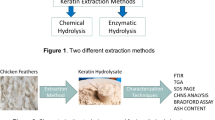Abstract
It is necessary to understand the changes that occur during the initial processing of lamb skins, because these will affect the final quality of the leather. The types of collagen, their macro and micro structures, the presence of proteins other than collagens, and the quantity and the type of proteoglycans, all have a profound effect on the quality of leather. Proteins isolated from untreated or raw sheep skin and from pickled skin (skins treated with sodium sulfide and lime followed by bating with enzymes, then preserved in sodium chloride and sulfuric acid) were significantly different when analysed by use of 2D gel electrophoresis and mass spectrometry. Agarose gel electrophoresis with a very sensitive sequential staining procedure has been used to identify the glycosaminoglycans present in raw and treated skin and their impact on quality of leather. Results showed that effective removal of proteoglycans acting as inter-fibrillar adhesives of collagen fibrils seemed to improve leather quality. Removal of these molecules not only opens up the fibre structure of the skin but may also be important in wool removal. The presence of elastin, which imparts elastic properties to skin, is of significant importance to tanners. The amino acids desmosine and isodesmosine, found exclusively in elastin, were quantitatively analysed to assess the role of elastin in leather quality.













Similar content being viewed by others
References
Cassano A, Drioli E, Molinari R (1997) Desalination 113:251–261
Cassano A, Drioli E, Molinari R, Grimaldi D, La cara F, Rossi M (2000) JSLTC 84:205–211
Aravindhan R, Saravanabhavan S, Raghava Rao J, Unni Nair B, Thanikaivelan P, Chandrasekaran B (2004) JALCA 99:53–66
Wilkins MR, Pasquali C, Appel RD, Ou K, Golaz O, Sanchez JC, Yan JX, Gooley AA, Hughes G (1996) Bio/Technology 14:61–65
Wilkins MR, Sanchez JC, Gooley AA, Appel RD, Humphery-Smith I, Hochstrasser DF, Williams KL (1996) Biotechnol. Genet Eng Rev 13:19–50
Kazlauskaite E, Balciuniene J, Zaliauskiene A, Beleska K, Valeika V, Valeikiene V (2002) JSLTC 86:59–64
Alexander KTW, Haines BM, Walker MP (1986) JALCA 81:85–100
Cooper S (1998) Proceeding of the New Zealand Leather and Shoe Research Association, Annual Conference. 49:31–44
Partridge SM (1962) Adv Protein Chem 17:227–302
Anwar RA (1966) Can J Biochem 44:725–734
Berkelman T, Stenstedt T, 2D Electrophoresis, Using Immobilized pH Gradients, Principles and Methods (Amersham Biosciences; 80–6429–60 Rev–A, 10/98)
Bradford MM (1976) Anal Biochem 72:248–254
Laemmli UK (1970) Nature 227:680–685
Gharahdaghi F, Weinberg CR, Meagher DA, Imai BS, Mische SM (1999) Electrophoresis 20:601–605
Aubert-Foucher E, Font B, Eichenberger D, Goldschmidt D, Lethias C, van der Rest M (1992) J Biol Chem 267:15759–15764
Sumner LW, Wolf-Sumner B, White SP, Asirvatham VS (2002) Mass Spectrom 16:160–168
Shevchenko A, Wilm M, Vorm O, Mann M (1996) Anal Chem 68:850–858
Thornton DJ, Hunt S, Huckerby TN (1983) Biochim Biophys Acta 757:219–225
Farndale RW, Sayers CA, Barrett AJ (1982) Connect Tissue Res 9:247–248
Volpi N, Maccari F (2002) Electrophoresis 23:4060–4066
Saito H, Ymagata T, Suzuki S (1968) J Biol Chem 243:1536–1542
Skinner SJM (1982) J Chromatogr 229:200–204
Yamaguchi Y, Haginaka J, Kunitomo M, Yasuda H, Bando Y (1987) J Chromatogr 42:253–259
Starcher BC (1977) Anal Biochem 79:11–15
Keller W (1990) Leder und Hautmarkt, Gerbereiwissenschaft und Praxis, 42:117–127
Stirtz T, Schroeder I (1982) Das Leder 33:67–78
Simpson DM, Beyon RJ, Robertson DHL, Loughran MJ, Haywood S (2004) Proteomics 4:524–536
Kronick PL, Iandola S (1997) JALCA 92:172–178
Kronick PL, Iandola SK (1998) JALCA 93:148–155
Ha GH, Lee SU, Kang DG, Ha N, Kim SH, Kim J, Bae JM, Kim JW, Lee C (2000) Electrophoresis 23:2513–2524
Bailey DG (1992) JALCA 87:26–35
Schoenherr E, Hausser H, Beavan L, Kresse H (1995) J Biol Chem 270:8877–8883
Scott PG, McEwan PA, Dodd CM, Bergmann EM, Bishop PN, Bella J (2004) PNAS 101:15633–15638
Goldoni S, Owens RT, McQuillan DJ, Shriver Z, Sasisekharan R, Birk DE, Campbell S, Iozzo RV (2004) J Biol Chem 279:6606–6612
Scott PG, Grossmann JG, Dodd CM, Sheehan JK, Bishop PN (2003) J Biol Chem 278:18353–18359
Herbert B, Galvani M, Hamdan M, Olivier E, MacCarthy J, Pedersen S, Righetti PG (2001) Electrophoresis 22:2046–2057
Myers ER, Armstrong CG, Mow VC (1984) Connect. Tissue Matrix 5:161–186
Chopra RK, Pearson CH, Pringle GA, Fackre DS, Scott PG (1985) Biochem J 232:277–279
Ameye L, Young MF (2002) Glycobiology 12:107–116
Roddy WT, O'Flaherty F (1938) JALCA 33:512–525
Manzo G (1988) Cuoio, Pelli, Materie Concianti 64: 276–285
Acknowledgements
The financial assistance provided by the Foundation of Research, Science and Technology in carrying out this research project is gratefully acknowledged. (Grant LSRX0201).
Author information
Authors and Affiliations
Corresponding author
Rights and permissions
About this article
Cite this article
Deb Choudhury, S., Allsop, T., Passman, A. et al. Use of a proteomics approach to identify favourable conditions for production of good quality lambskin leather . Anal Bioanal Chem 384, 723–735 (2006). https://doi.org/10.1007/s00216-005-0228-x
Received:
Revised:
Accepted:
Published:
Issue Date:
DOI: https://doi.org/10.1007/s00216-005-0228-x




